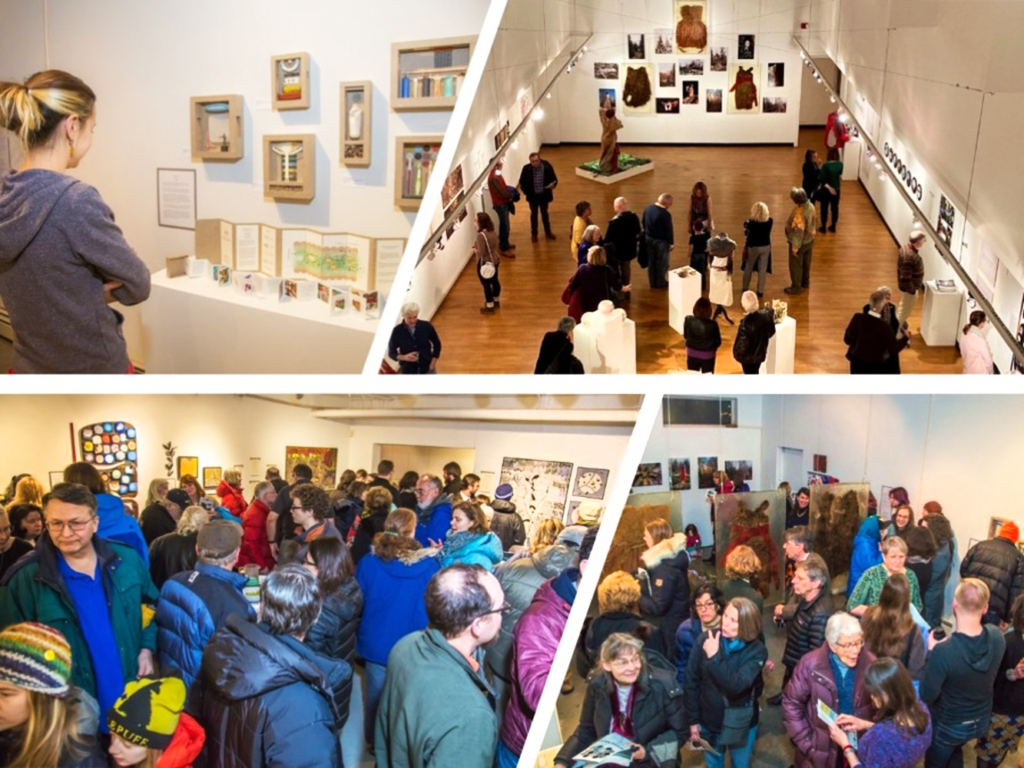In a Time of Change
A Nested Ecosystem of Environmental Arts, Humanities, and Science Collaboration
Mary Beth Leigh and Lissy Goralnik
Ground Works | August 2022
Abstract
The integration of environmental science with arts and humanities (eSAH) has the potential to advance public understanding of science while inspiring emotional responses and attitude shifts that lead to pro-environmental behavior. The In a Time of Change (ITOC) program, an eSAH incubator in Alaska, uses place as a boundary object to bridge relationships between artists, writers, and scientists. Participants co-investigate a place-based environmental theme over the course of a year, then present their work at a public exhibit. At these exhibitions, the art and writing about place become boundary objects themselves around which broader publics gather to engage with ideas and landscapes. In this article, we describe the ITOC program and the broader ecosystems of eSAH work in which it is nested, including the U.S. National Science Foundation’s Long-Term Ecological Research (LTER) network, where most sites host some kind of eSAH inquiry. We then use the case study of a recent ITOC project, Microbial Worlds, to demonstrate the ways relationships between artists, writers, and scientists are transmitted to audiences through eSAH collaborative exhibits, resulting in impacts to audience knowledge and attitudes about the natural world and broad support for eSAH approaches to environmental problem solving.
INtroduction
Public understanding of science is critical as society faces social-ecological challenges that are growing in intensity and number, including the broad-reaching effects of climate change. The integration of environmental science with arts and humanities (eSAH) can appeal to diverse publics by catalyzing emotional responses to environmental issues, which can prime learning and impact attitude shifts and pro-environmental behavior. But there are epistemological and practical challenges to eSAH collaborations. Boundary objects (Star & Griesemer, 1989) – information or objects used by different communities in different ways – can help overcome these challenges by promoting collaboration between artists, humanities scholars, and scientists. They provide a shared focus for co-creation and a context to unpack different approaches to inquiry.
In a Time of Change (ITOC), an eSAH incubator associated with the Bonanza Creek Long-Term Ecological Research (LTER) program in interior Alaska, uses place as a boundary object to bridge relationships between artists, writers, and scientists. Participants co-investigate a place-based environmental theme, e.g. the role of microbes in changing Northern ecosystems, over the course of a year, then present their work at a public exhibit. At these exhibits, the art and writing themselves become boundary objects around which broader publics gather to engage with ideas and landscapes. Since its establishment in 2008, the ITOC model has evolved in response to our research on audience and participant impacts, moving toward a relationship-centered program focused on process rather than product, to facilitate informal learning and connections at every stage of the collaborative experience.
In this article, we describe the ITOC program and the broader ecosystem of eSAH work in which it is nested, including the U.S. National Science Foundation’s LTER network, where most sites host some kind of eSAH inquiry, and a larger trend of eSAH work across venues, contexts, and purposes. We then use the case study of a recent ITOC project, Microbial Worlds, to demonstrate the ways relationships between artists, writers, and scientists are transmitted to audiences through eSAH collaborative exhibits, resulting in impacts to audience knowledge and attitudes about the natural world and broad support for eSAH approaches to environmental problem solving.
Background
In a Time of Change (ITOC), established by the Bonanza Creek Long-Term Ecological Research program in Fairbanks, Alaska, in 2008, is an eSAH program that facilitates collaborative relationships and produces exhibits, performances, and public events focused on social-ecological themes such as climate change, wildfire, predator control, microorganisms, and other dimensions of Northern ecosystems. The most recent project, Microbial Worlds, focused on the many roles microbes play in human and environmental health, including functions that positively and negatively impact society and the environment. Artists and writers highlighted the fact that while some microbes cause disease and contribute to climate change by releasing the greenhouse gas methane from thawing permafrost, others are responsible for maintaining healthy ecosystems through decomposition, nutrient cycling, and removal of toxic pollutants from the environment. Microbes can also promote plant, animal, and human health through symbiotic or commensal relationships occurring in the human gut microbiome and in mycorrhizal fungal partnerships with boreal forest trees. The Microbial Worlds collaborative arts-humanities-science exhibit drew large audiences at its Fairbanks premiere and subsequent touring exhibitions across Alaska as well as in Oklahoma, Oregon, and Finland (Fig. 1). Audience survey data demonstrated that the exhibit contributed to increased knowledge about the roles of microbes in ecosystems and the effects of human activities on ecosystems. Participants also demonstrated an increased motivation to learn more about microbes and an increased appreciation of science more broadly.

Figure 1. The Microbial Worlds exhibit premiered on February 3, 2017, at Well Street Art Company in Fairbanks, Alaska (top left and lower images), to a record-setting audience of over 900 attendees in one evening, accounting for 2.5% of the City of Fairbanks population. The exhibit includes original art works and writings by Alaskan artists Susan Campbell, Annie Duffy, Nancy Hausle-Johnson, Jessie Hedden, Eric Henderson, Mariah Henderson, Margo Klass, Debbie Clarke Moderow, Jennifer Moss, Ree Nancarrow, Gail Priday, and Sara Tabbert, Brooklyn artist Stephanie Rae Dixon, and San Diego artist Charlotte Bird. Mary Beth Leigh, ITOC director and professor of microbiology at the University of Alaska Fairbanks (UAF), directed the project. Artists in the program developed works inspired by the world of microorganisms, including their visual beauty and many roles in human and environmental health. The artistic media represented included painting, sculpture, tile, printmaking, textile art, artist books, writing (poetry and memoir/essay), and multimedia works. The exhibit subsequently toured to multiple venues, including the University of Oklahoma (top right).
